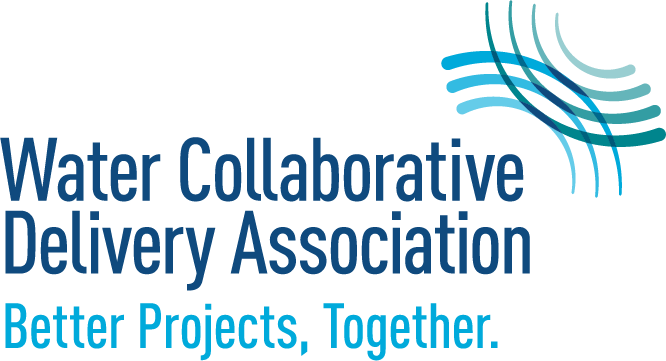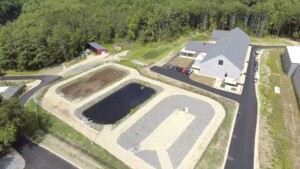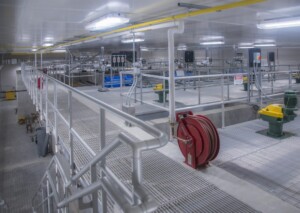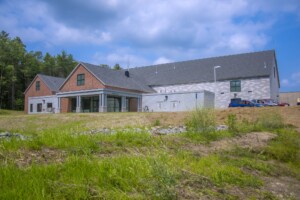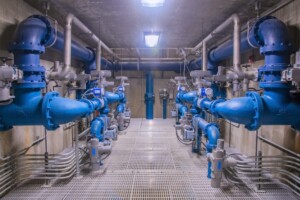Challenge
The University of New Hampshire (UNH) owns and is responsible for operations of a water treatment plant (WTP) that serves the entire campus as well as the Town of Durham, NH. The original WTP was constructed in the early 1930s, and even though it continued to meet drinking water requirements, UNH decided to build a new facility due to the age of the equipment and structures.
In addition to providing clean water for approximately 29,500 people, the design of the new WTP needed to address several unique needs for UNH. First, the project site is adjacent to College Woods, a 250-acre area of woods, streams, and fields used by UNH and area residents for recreation and research. Design and location needed to protect this valuable outdoor resource. Second, the WTP would be used as a training lab for UNH students studying water resources engineering. Third, and most complex, were the process and permitting challenges presented by existing regulations and variant water sources.
Approach
Prior to procurement of a design-build team, UNH selected an owner’s project manager to assist with pilot testing to identify design criteria for the new water treatment plant and to assist with future procurement. The owner, in consultation with the owner’s project manager, selected a design-build approach to allow for stakeholder input throughout the project and to accelerate the project schedule. The client’s campus planning department reviewed multiple iterations of conceptual designs, constructability reviews were conducted by the design-build team, and operability reviews were performed by both Woodard & Curran’s operations group and existing UNH WTP operations staff. Throughout the entire project, this process was fully transparent with close collaboration between the university and design-build team.
At several points during the design process, there were process design workshops with the owner, owner’s project manager, design-build team, and operations staff. The New Hampshire Department of Environmental Services (NHDES) and other regulators were also heavily engaged in the design process beginning with preliminary design to ensure that the design-build team could proactively address potential permitting concerns.
Lastly, the design-build team engaged with the university’s engineering department to solicit input from teaching staff relative to the design of the facility and additional components, such as a separate student laboratory (isolated from the main process area for security reasons), that could be included to provide further benefit to the university and its students.
The design team took care in situating the facility to minimally impact College Woods. While the new plant required some trees to be cut, the team coordinated with the university’s facilities staff to properly balance protection of existing trees with space requirements for the new WTP. While the plant’s design had to maintain the same treatment capacity, the new facility was designed to have full redundancy of all equipment and provide enough space to facilitate maintenance and operations for the foreseeable future.
Woodard & Curran designed the new treatment building with a capacity of 2 million gallons per day (mgd). The facility is equipped with three residuals lagoons, an open process area that is visible through interior windows, and a training lab for engineering students to perform experiments. Unlike the old facility, the new plant site is located above the 100-year flood plain and will better handle the varied range of water characteristics from the three water sources.
Developing the treatment process for the new WTP was unique due to the extreme variability in three different raw water supply resources and an additional recycle stream necessary to render the facility as zero discharge. Water drawn from the Lamprey River, Oyster River, and Spruce Hole Well has varying characteristics, requiring different levels of treatment. The variability of water sources coupled with the need to blend supplies and treat recycled flows can be challenging for operators to treat. The new WTP includes flow-rate controls at each of the four sources, allowing operators the ability to control how much of each supply is coming into the treatment process and better anticipate treatment needs. Online instrumentation is used to alert operators of raw water quality changes, including turbidity, pH, and temperature, which helps better manage treatment strategies and optimize operations.
The university’s complex water withdrawal permit also allows groundwater recharge at the Spruce Hole Well from the Lamprey River during periods of high flow. A portion of the water pumped from the Lamprey River during high flows is diverted to recharge basins at the Spruce Hole Well where it is stored within the aquifer and available as a groundwater supply during periods when the river flows are lower. This complex supply and recharge scheme was incorporated into the new WTP’s overall control and reporting methodology to satisfy regulatory requirements, maximize available flow to the plant, and minimize environmental impacts.
The most challenging aspect of the project was construction sequencing. Throughout construction, the existing plant needed to remain fully operational until the new WTP began treating water that was ready for distribution to the campus and town. Not only did this limit the area in which a new plant could be situated, but it also required eliminating the existing residuals drying beds, which were located where the new WTP and lagoons were to be constructed. The complex construction sequence included prioritization of the installation of Lagoon #3 to be used as a temporary dewatering bed to accommodate residual sludge from the existing lagoons in the time between eliminating the existing WTP’s drying beds and taking the existing WTP and lagoons out of service. The three new residuals handling lagoons were constructed at different times over the course of the project as space constraints and operational needs changed. Space for the third lagoon only became available after the new plant was placed into service and most demobilization activities had occurred.
The new treatment process includes rapid mix, flocculation, plate-settler clarification, multi-media filtration, and disinfection. Additionally, there is corrosion control, pH adjustment, and fluoridation. There is also a supplemental chemical feed system and multiple dosing points for seasonal manganese treatment using potassium permanganate. Below grade, concrete tanks include two backwash supply tanks from which non-chlorinated water is pumped for filter backwashing operations, two disinfection contact time tanks and three independent clearwells, all of which provides significant redundancy in the overall treatment process.
Results
After several years of careful planning, design, and construction, the original facility has been replaced with an efficient, state-of-the-art, 26,000-square-foot WTP designed to treat and deliver up to two million gallons of high-quality drinking water per day. The new plant, delivered under a collaborative design-build contract, is the first of its kind in New Hampshire. The unique treatment process is designed to accommodate three very different source waters, as well as a significant population flux. UNH has upwards of 13,000 undergraduate students on campus between September and May, adding to Durham’s year-round population of approximately 16,500.
The project was expedited by the collaborative delivery method with construction starting while final design details were being finalized, which also reduced the amount of time the old facility needed to remain operational.
Over 75,000 labor hours were required to design and construct the new facility. The project has recently been submitted for multiple awards. We are awaiting the results of these submissions.
“Working through the design-build process with Woodard & Curran and their construction partner, Waterline Industries, allowed us to enjoy close collaboration and continued input throughout the project. We are extremely pleased to have a beautiful, modern treatment facility that not only meets the water supply needs of the campus and the town efficiently and reliably, but also provides a great learning resource for the university’s students. The design-build procurement allowed us to continue design improvements for the betterment of the long term operations because we were able to begin construction while finalizing later portions of the design. The project has been a great success.”
— Matt O’Keefe, Director of Energy and Utilities, University of New Hampshire
